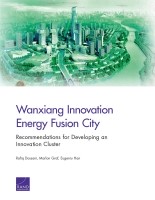| 来源类型 | Research Reports
|
| 规范类型 | 报告
|
| DOI | https://doi.org/10.7249/RR2035
|
| ISBN | 9780833099013
|
| 来源ID | RR-2035-WXG
|
| Wanxiang Innovation Energy Fusion City: Recommendations for Developing an Innovation Cluster |
| Rafiq Dossani; Marlon Graf; Eugeniu Han
|
| 发表日期 | 2017
|
| 出版年 | 2017
|
| 页码 | 86
|
| 语种 | 英语
|
| 结论 |
Stuttgart Automotive Cluster- The Stuttgart region's endowment of human capital resources and closely networked, globally oriented large firms, small- and medium-sized enterprises (SMEs), and universities are driving forces behind its sustained success. The universities work with large firms and SMEs to sustain Germany's dual education system of specialized training combined with practical work experience. They also undertake joint research programs with firms for technology development. Government agencies and trade associations connect various actors across the cluster and facilitate interdisciplinary collaborations.
- While the cluster is considered healthy, its specialization in traditional automotive technologies presents challenges for the future as it transitions to a digital automotive environment and explores alternative technologies. Given the conservative strategies of the region's anchoring car manufacturers and the high degree of niche specialization of many small firms, the cluster might find it difficult to adapt in the short term.
Aichi Automotive Cluster- The Aichi cluster's rich historical tradition of manufacturing, skilled labor, globalized large firms, and networked SMEs are the major driving forces for the cluster's success. Large firms are horizontally integrated and rely on sophisticated SMEs to contribute technology-intensive critical components. However, these SMEs rely on the large firms for access to technology, finance, product design, and quality assurance. They are closely linked to the large firms through long-term contracts, co-ownership, and financial co-guarantees.
- The universities sustain a flow of high-quality talent to the cluster, but have limited roles in research and development. Government support for university-industry interaction and for SME development is limited and ineffective.
WIEFC's Local Context- Hangzhou's higher education system, which includes Zhejiang University, a university with world-class engineering programs; the presence of several skilled automotive firms in Hangzhou; and a skilled workforce offer resources that may be leveraged to create the WIEFC automotive cluster.
|
| 摘要 |
Policies for Technology Development- Develop technologies through joint research between research institutions and firms at the Centers of Excellence (COEs).
- Access new technologies through licensing, research programs, and other ways of developing and protecting intellectual property through the Business Development Association (BDA).
Policies for Talent Development- Attract research-oriented talent and build research capacity through the COEs.
- Develop workforce capacity through the establishment of an internship and apprenticeship program in collaboration with the leading technical training colleges and universities in the area. This program would be managed by the BDA.
- Attract technical and innovative talent through the establishment of a jobs program to be managed by the BDA.
Policies for Client and Vendor Development- Build supply chains by linking firms within the cluster through the BDA.
- Identify and bridge gaps in the supply chain within the cluster by inviting new firms to the cluster through the BDA.
- Develop a client and vendor base outside the cluster by building relationships with clients and vendors through the activities of the BDA.
Policies for Standards Development- Develop and implement standards for firms' manufacturing processes through the establishment of a benchmarking institute (BI) located at WIEFC. Membership in the BI would be open to all firms located in WIEFC.
|
| 主题 | Alternative and Renewable Energy
; Alternative Fuel Vehicles
; China
; Economic Development
; Economic Planning
; Emerging Technologies
; Science
; Technology
; and Innovation Policy
|
| URL | https://www.rand.org/pubs/research_reports/RR2035.html
|
| 来源智库 | RAND Corporation (United States)
|
| 引用统计 |
|
| 资源类型 | 智库出版物
|
| 条目标识符 | http://119.78.100.153/handle/2XGU8XDN/108620
|
推荐引用方式
GB/T 7714 |
Rafiq Dossani,Marlon Graf,Eugeniu Han. Wanxiang Innovation Energy Fusion City: Recommendations for Developing an Innovation Cluster. 2017.
|
|
文件名:
|
x1513093675230.jpg
|
|
格式:
|
JPEG
|

|
文件名:
|
RAND_RR2035.pdf
|
|
格式:
|
Adobe PDF
|
除非特别说明,本系统中所有内容都受版权保护,并保留所有权利。